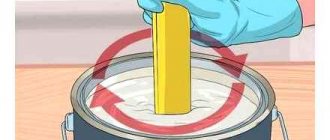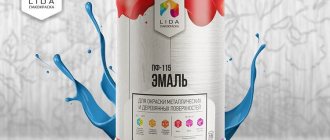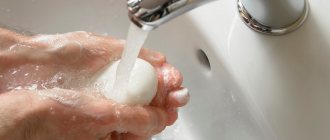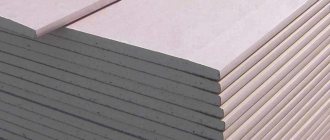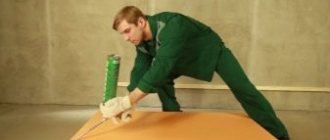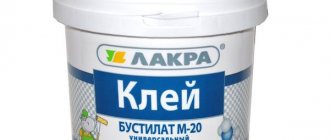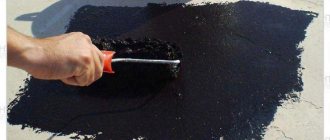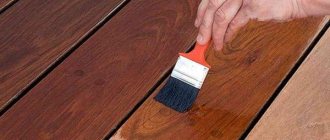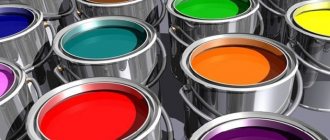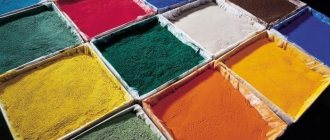Bituminous varnish is one of the most popular paint and varnish materials. What is the secret of its popularity and how to use bitumen varnish you will learn in this article.
The high demand for this material explains its composition. The varnish is based on bitumen. This is a viscous plastic component, natural or synthetic. Its main property is its ability to withstand aggressive chemicals that destroy building materials.
Varnish characteristics
The presence of these additives in the composition of bitumen varnish explains its high technical characteristics:
- dries quickly: from 20 hours;
- withstands sudden changes in temperature, rain, snow, direct sunlight;
- not afraid of frost, resistant to cracks in the coating;
- reliably protects any building materials from water;
- resists corrosion processes of metal and concrete;
- protects wood from fungi and mold;
- high degree of adhesion to other surfaces.
Characteristics
The bitumen composition is a liquid with an oily structure. This substance may be colorless or brown. When using it, you need to be careful, following safety rules. Below are several main characteristics characteristic of bitumen paints and varnishes; these characteristics depend on the components from which the bitumen product is made:
- viscosity index;
- how long does it take to dry?
- bending elasticity of the dried varnish layer;
- high temperature resistance;
- resistance to moisture;
- varnish consumption per m2;
- indicator of adhesion to wood, concrete or metal.
Bituminous varnishes are inexpensive to produce. They are very simple, easy and quick to apply to the surface; the surface is treated with a roller or brush. Bituminous varnish is used in many areas; this solution creates an even, uniform protective layer, without smudges, and covers various types of materials well. Bituminous varnishes have different consumption, depending on the type of mixture; usually during the application process it is necessary from 100 to 200 milliliters of varnish to treat one square meter.
The scope of application of bituminous varnishes is very extensive. The varnish is used to process all kinds of supports, plumbing equipment, various construction projects, and metal gates. Also, bitumen-based varnish mixtures are used to protect various equipment and structures from damage during their storage, transportation and operation.
Application area
The composition of the varnish allows it to be used for various purposes, such as protecting various structures and premises made of wood, steel, concrete and slate from water penetration.
It also has excellent adhesive properties: it is used for gluing rolled and roofing materials, and also serves as a good primer.
It is common in the design field: it is used to create an “aging effect” in decorative fakes and the like.
Areas of use
Used in industrial production and at home for the following purposes:
- Protection of metal, concrete industrial and building structures from rust.
- Preservation for storage, transportation of metal products and other materials.
- Waterproofing the foundations of houses, garages, swimming pools, basements.
- Bonding roofing materials.
- Preservation of parts in electrical engineering.
- Creation of micalenta.
- Electrical insulation.
- The use of bitumen varnish to protect wooden buildings.
A new and unusual area of application for bitumen varnish – decoupage – has made the material popular among creative enthusiasts.
To give an “antique effect” to products, varnish is indispensable. Bitumen highlights cracks and depressions on baguette, stucco molding, and emphasizes the natural structure of wood.
The varnish should be applied with a flat synthetic brush. Excess is removed with a soft natural cloth. If necessary, excess blackness is removed with white spirit 2-4 hours after application. Experts advise not to apply more than two layers of varnish.
Application in decoupage
The decoupage effect is used to give an aged look to products, which will look appropriate in a certain interior style. Decoupage gives the product expressiveness and relief, an original look. You can get the desired result by darkening the pits and highlighting the bulges. The designer also makes small cracks on the surface.
For aging, bitumen varnish is usually used. It is applied with a small brush, then with a rag or foam sponge, drips and excess are removed, and wiped until the coating dries. At the same time, darkening and highlighting are adjusted in individual areas. Also, after complete drying, they give the final look to the decor by wiping the desired areas with white spirit to brighten. Excess is removed using a solvent.
If the surface is wooden, then the varnish penetrates into the cracks, emphasizing the structure of the wood. It is used to decorate stucco moldings, furniture, and bas-reliefs.
Drying takes 12 to 24 hours. The final result is fixed with alkaline varnish.
Mode of application
- clean the required surface from dust;
- prepare a place to work outside;
- stir the solution thoroughly;
- if necessary, dilute with organic solvent: white spirit, toluene, turpentine
- paint with a brush or roller; small parts can be dipped into the solution; for large volumes, use a sprayer.
After painting, the product acquires a beautiful, uniform black glossy layer.
Storage and Security
The presence of solvents and other synthetic components makes BT-577 varnish toxic to humans. It should be applied to products only in strict compliance with safety rules. The respiratory tract is protected with respirators and gas masks; the room must be equipped with supply and exhaust ventilation. It is safer to carry out work in open areas. Hands are protected with gloves, body - with thick clothing.
If the material gets into your eyes or skin, wash them immediately with water (the skin, if necessary, can be wiped with any solvent, then washed well with soap). If varnish gets into the stomach, you should induce vomiting, rinse, take sorbents and drink plenty of liquid.
The material is explosive and flammable. It is stored only in an unheated room, tightly closed, away from any sources of fire or heat. Shelf life – 6 months, store away from moisture and sunlight.
Safety precautions when working with varnish
Follow safety precautions:
- remember that bitumen varnish is toxic: do not work with it in the house, in the presence of children and animals;
- do not keep near fire, do not heat, do not smoke near: this is a flammable and explosive mixture;
- wear gloves and overalls when working with varnish;
- Wash quickly with running water if the product gets on your face.
Main characteristics
Bituminous varnish characterizes itself as a brown liquid substance. There are also colorless options.
The following characteristics: drying time, hardness, holding time and minimum content of non-volatile substances depend on the composition used during the production of this product. We will consider them using the example of well-known representatives.
BT-5100
BT-5100 is popular. There is no oil in the composition, there is only petroleum bitumen and organic solvents.
This is a quick drying varnish. In 2 hours at a temperature of 20 degrees in the open air, the varnish will dry completely. Actively used when working with roofing felt.
Purpose of the material
The product is widely used in construction, in everyday life, in a number of industrial sectors, and in agriculture. Its use is effective on working devices and equipment, on products subject to transportation and storage for up to 6 months. This product is often used to coat agricultural machinery that is to be preserved. The surfaces to be treated must be made of metal and wood, but varnish is often used on surfaces made of slate, brick, and other materials.
Examples of material application:
- wooden posts and crowns of buildings (to prevent rotting);
- walls, floors, ceilings of cellars, basements for protection from moisture;
- garages;
- swimming pools.
The varnish is suitable for imparting decorative properties to any surface, especially old ones. Due to its excellent adhesion to any base, it can be used as an adhesive; it can be used to connect roll and sheet materials. Also, BT-577 varnish is used for the production of paint of the same name, this is its no less important purpose.
Electrical insulating varnishes
Electrical devices and machines, household and industrial, need reliable insulation to preserve human life and health.
To create the required degree of insulation, varnishes are used that have:
- high degree of heat resistance;
- heat shrinkability;
- quick-drying when applied in a thick layer.
Quick-drying, odorless paint for interior work - main types, selection tips and benefits of useThe best aerosol paint in cans - main types, application features and advantages of use
The best water-based paint - ranking of the best manufacturers of 2018
These are brand varnishes
- BT-99
- BT-980
- BT-987
- BT-988
Surface application methods:
- impregnation,
- dipping,
- pneumatic or airless spraying.
Basic properties of varnish
The material is designed to protect metal products from damage, therefore its properties are as follows: resistance to atmospheric conditions - snow, rain, fog, temperature changes. The coating obtained after applying the product does not fade under sunlight for a long time, is frost-resistant, and is not damaged by regular exposure to water, including sea water.
The varnish protects structures and other products from corrosion and prevents the spread of existing rust. It also has antiseptic properties - after its application, the proliferation of fungi, mold, and microbes stops. Wooden surfaces will be reliably protected from rot.
Recommendations for purchasing varnish
If a large volume of various construction works is planned, it is worth purchasing universal coatings: Kuzbasslak BT - 577 GOST 5631-79 or varnish BT-123.
Carefully look at the photo of bitumen varnish. Remember what the solution looks like externally, what container it is sold in, what packaging by weight exists. This will help you navigate the store. Read the instructions on the product label.
Manufacturers of bituminous varnishes warn how long the material can protect the product from rust. Some varnishes have a corrosion protection period of 6 months when applied in one layer, while more expensive varnishes have a longer period of protection.
How to choose façade paint for exterior use - a review of popular manufacturers and a rating of the best paints for exterior useWhich oil paint is better - a review of the best brands and criteria for selecting paints
The best interior paint for walls - 2021 rating and instructions for using interior paint
Don't forget about the expiration date. It is specified by the manufacturer and is usually 6 months. Calculate the required amount of material at the rate of 100-200 ml per person. Purchase containers of varnish based on your needs. This will save you money.
Bituminous varnish BT-577 technical characteristics
Bitumen tank BT-577
Kuzbasslak is the most popular type of oil-free bitumen-containing coatings. The use of additives and driers in the formulation is allowed. White Spirit and turpentine can be used as a thinner. The main direction of use is the preservation of metals during the period between operations, anti-corrosion protection during storage of metal products. The period of use of the protective film is up to 6 months. Suitable for application to wooden substrates and other materials exposed to atmospheric conditions. The appearance of the coating is gloss/semi-gloss black, the shade is not standardized. Based on BT-577, by adding a suspension of aluminum powder, BT-177 paint (aluminum paint) is obtained.
Main technical characteristics according to GOST 5631-79:
- The share of non-volatile substances is 39%.
- Viscosity at 20C, sec – 18-35 (VZ-4).
- Drying time – 24 hours at 20C, 20 minutes at 100-110C.
- Elasticity under bending loads – less than 1mm.
- Consumption per 1m2 – 100-120g.
Oil-free, quick-drying bitumen varnish BT-5100 is used to apply a protective film to the internal surfaces of metal parts.
Photo of bitumen varnish
Types of solvents
For convenience, we divide all solvents into the following groups:
- Solvents for paints and varnishes (paints, enamels, varnishes), as well as adhesives and primers
- Solvents for building materials (solvents for bitumen, concrete, foam, rubber, rust, etc.)
- Household solvents (stains from oil, grease, tape, etc.)
- Artistic solvents
Solvents for paints and varnishes
Almost all solvents for varnishes, paints and enamels are volatile organic substances with a low boiling point. These properties ensure rapid drying of the compositions after application.
There are solvents:
— homogeneous - based on one substance or a mixture of homogeneous substances (for example, toluene);
- combined - based on several homogeneous solvents in a certain proportion (for example, P-4 = toluene + acetone + butyl acetate).
As a rule, combined ones are characterized by higher efficiency and targeted action.
Using our table, you can easily understand which solvents are used for which paints.
Purpose of solvents
| Solvent | Type of paintwork |
| Homogeneous solvents | |
| Water | Solvent (or rather thinner) of acrylic paint, water-based paint and other water-based paints and biting |
| Gasoline (gasoline galoshes, nefras) | Solvent for oil and bitumen paints, varnishes, enamels |
| Turpentine | Solvent for oil and alkyd-styrene paints |
| White Spirit | Solvent for oil and alkyd paints and enamels (including PF-115, PF-133, PF-266), bitumen mastics, varnish GF-166, primer GF-021 |
| Solvent (petroleum) | Solvent for glyphthalic and bituminous varnishes and paints (including melamine alkyd). |
| Xylene (petroleum) | Solvent for glyphthalic and bituminous varnishes and paints, epoxy resin. |
| Acetone | Solvent for perchlorovinyl paints |
| Combined (registered) solvents | |
| Solvent 645 | Nitrocellulose solvent |
| Solvent 646 | Universal solvent for nitro paints, nitro enamels, general purpose nitro varnishes, also epoxy, acrylic, solvent |
| Solvent 647 | Solvent for nitro enamels, nitro varnishes for cars |
| Solvent 649 | Solvent NTs-132k; GF-570Rk |
| Solvent 650 | Automotive enamels solvent NTs-11; GF-570Rk |
| Solvent 651 | Oil solvent |
| Solvent R-4 | Polyacrylate, perchlorovinyl, coatings with copolymers of vinyl chloride with vinylidene chloride or vinyl acetate |
| Solvent R-5 | Perchlorovinyl, polyacrylate, epoxy |
| Solvent R-6 | Melamine-formaldehyde, rubber, polyvinyl-butyral |
| Solvent R-7 | Dilution of varnish VL-51 |
| Solvent R-11 | Perchlorovinyl, polyacrylate |
| Solvent R-14 | Epoxy enamels cured with isocenate hardeners |
| Solvent R-24 | Perchlorovinyl |
| Solvent R-40 | Epoxy |
| Solvent R-60 | Cresol-formaldehyde, polyvinylbutyral |
| Solvent R-83 | Epoxy ester |
| Solvent R-189 | Solvent for polyurethane varnish |
| Solvent R-219 | Polyester resin solvent |
| Solvent R-1176 | Solvent for polyurethane paints and enamels |
| Solvent RL-176 | Polyacrylate, polyurethane |
| Solvent RL-277 | Polyurethane |
Other useful properties of these solvents:
— cleaning and degreasing the surface;
— removal of paintwork materials from brushes, rollers, spatulas and other tools.
Video about what solvent to rinse the spray gun with
Solvents for removing paint: fresh and old
If, during the work, paint stains ended up in the wrong place (stained furniture, floor, glass), it can be removed with the solvents indicated in the table. True, for delicate surfaces (wood, laminate, plexiglass) you should not use combined compounds like R-646. It is better to use homogeneous ones and be sure to first test their effect on an inconspicuous area.
Special solvents are produced for removing old paints from large areas. They will help remove paint from walls, metal products, etc.


